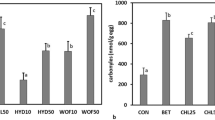Abstract
Eggs of the European lobster, Homarus gammarus (L.), were exposed to malachite green (5, 10, 15 mg 1−1: 10 min), glutaraldehyde (50, 100, 150 mg 1−1: 3 min) and iodine as BuffodineTM (50, 100, 150 mg 1−1: 10 min). The efficiency of the treatments was tested by incubating eggs individually in wells of multiwell dishes with TSB agar for 14 days after exposure. In order to find any effect on viability, batches of 30 eggs from each of three females were incubated artificially in a recirculation system for 19 days and repeatedly exposed to the disinfectants. Iodine as Buffodine (150 mg 1−1) was the only treatment that resulted in a significant decrease of the bacterial growth on lobster eggs, but the treatment also resulted in inhibited hatching compared with the control group. Thus, our results indicate that treatment with 150mg−1 iodine as Buffodine could be a strategy for reducing bacterial growth on lobster eggs when massive egg mortality due to bacteria is otherwise unavoidable. The treatment could, however, lead to decreased viability of larvae due to inhibited hatching.
Similar content being viewed by others

References
Alderman, D.J. (1984) The toxicity of iodophores to salmonid eggs. Aquaculture 40, 7–16.
Amend, D.F. (1974) Comparative toxicity of two iodophores to rainbow trout eggs. Transactions of the American Fisheries Society 103, 73–78.
Beard, T.W., Richards, P.R. and Wickins, J.F. (1985) The techniques and practicability of year-round production of lobsters, Homarus gammarus (L.), in laboratory recirculation systems. Fisheries Research Technical Report, MAFF Directory of Fisheries Research, Lowestoft No. 79, 22 pp.
Bergh, ø. and Jelmert, A. (1990) Antibacterial treatment procedures of eggs of halibut (Hippoglossus hippoglossus L.). Council Meeting, International Council for the Exploration of the Sea. F:39.
Fisher, W.S. (1976) Relationships of epibiotic fouling and mortalities of eggs of the Dungeness crab (Cancer magister). Journal of the Fisheries Research Board of Canada 33, 2849–2853.
Fisher, W.S. (1977) Epibiotic microbial infestations of cultured crustaceans. Proceedings of the World Mariculture Society 8, 637–684.
Fisher, W.S. (1986) Defences of brooding depacod embryos against aquatic bacteria and fungi. In: Pathology in Marine Aquaculture (eds C.P. Vivares, J.R. Bonami and E. Jaspers) Special Publication 9, European Aquaculture Society: Bredene, Belgium, pp. 357–363.
Fisher, W.S., Rosemark, T.R. and Schleser, R.A. (1976) Toxicity of malachite green to cultured American lobster larvae. Aquaculture 8, 151–156.
Fisher, W.S., Nilson, E.H., Steenbergen, J.F. and Lightner, D.V. (1978) Microbial diseases of cultured lobsters: a review. Aquaculture 14, 115–140.
Gil-Turns, M.S. and Fenical, W. (1992) Embryos of Homarus americanus are protected by epibiotic bacteria. Biological Bulletin 182, 105–108.
Jennings, J.B. and Gelden, J.K. (1976) Observations on the feeding mechanisms, diet and digestive physiology of Histriobdella homari (van Beneden, 1858), an aberrant polychaete symbiotic with the North American and European lobster. Biological Bulletin 151, 498–517.
Næss, T. and Bergh, ø. (1994) Calanoid copepod resting eggs can be surface-disinfected. Aquacultural Engineering 13, 1–9.
Sadusky, T.J. and Bullis, R.A. (1994) Experimental disinfection of lobster eggs infected with Leuchothrix mucor. Biological Bulletin 187, 254–255.
Salvesen, I. and Vadstein, O. (1995) Surface disinfection of eggs from marine fish: evaluation of four chemicals. Aquaculture International 3, 155–171.
Schachte, J.H. (1979) Iodophore disinfection of Muskellunge eggs under intensive culture in hatcheries. The Progressive Fish-Culturist 41, 189–190.
Sokal, R.R. and Rohlf, F.J. (1981) Biometry (second edition) W.H. Freeman and Company: New York, pp. 691–767.
Subasinghe, R.P. and Somerville, C. (1985) Disinfection of Oreochromis mossambica (Peters) eggs against commonly occurring potentially pathogenic bacteria and fungi under artificial hatchery conditions. Aquaculture and Fisheries Management 16, 121–127.
Waddy, S.L. and Aiken, D.E. (1991) Egg production in American lobster, Homarus americanus. In: Crustacean Egg Production (eds A.M. Wenner and A. Kurvis) Balkema: Amsterdam, pp. 267–288.
Wickins, J.F., Beard, T.W. and Child, A.R. (1995) Maximizing lobster, Homarus gammarus (L.). egg and larval viability. Aquaculture Research 26, 379–392.
Author information
Authors and Affiliations
Rights and permissions
About this article
Cite this article
Uglem, I., Elias Uksnøy, L. & Bergh, ø. Chemical treatment of lobster eggs against epibiotic bacteria. Aquacult Int 4, 1–8 (1996). https://doi.org/10.1007/BF00175216
Issue Date:
DOI: https://doi.org/10.1007/BF00175216



